| Home | Nature Weekly Index |
19 March 2017 | Walk at the Park |
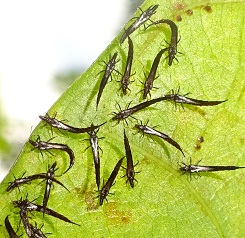

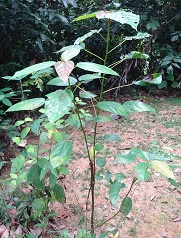 While on a brief walk at the nearby park a month back, I came across a young
Ficus variegata (Common Red-stem Fig) by the side of the track. Most of
its leaves were infected with hairy galls, similar to the ones that I
shared in January. Upon closer examination, I found out that the
infection was not limited to galls. There were also many tiny blank and slender thrips on the underside of its leaves.
Including young ones and plenty of eggs. The attack by the thrips had resulted in yellow patches on the
leaves seen from the top. Nevertheless, the attack was still at its infancy. The thrips were not the cause of the galls as
I had already knew the causative agent from past observation --- a type of jumping plant louse.
While on a brief walk at the nearby park a month back, I came across a young
Ficus variegata (Common Red-stem Fig) by the side of the track. Most of
its leaves were infected with hairy galls, similar to the ones that I
shared in January. Upon closer examination, I found out that the
infection was not limited to galls. There were also many tiny blank and slender thrips on the underside of its leaves.
Including young ones and plenty of eggs. The attack by the thrips had resulted in yellow patches on the
leaves seen from the top. Nevertheless, the attack was still at its infancy. The thrips were not the cause of the galls as
I had already knew the causative agent from past observation --- a type of jumping plant louse.
When I was back last week (3 weeks later), the attack was at its height. Literally, swam of the thrips were hovering around the leaves. I had also seen thrips on another wild fig leaves, the Malayan Banyan. But, never had I seen such massive scale of attack. Being a resilient plant, I believed the young fig tree will eventually survive after shedding the currently infected leaves.

 Another noteworthy observation was the
Japanese Queenless Ant (Pristomyrmex punctatus),
assuming that I got its identity correct, found roaming along the stem of the
Straits Rhododendron (Melastoma malabathricum) and the leaves
of a young Sea Apple (Syzygium grande). This was the first time that
I saw it in this park. It looked very similar to
Asian Army Ant (Carebara diversa), except
that it had only one size, unlike the varying sizes of the Asian Army Ant.
Another noteworthy observation was the
Japanese Queenless Ant (Pristomyrmex punctatus),
assuming that I got its identity correct, found roaming along the stem of the
Straits Rhododendron (Melastoma malabathricum) and the leaves
of a young Sea Apple (Syzygium grande). This was the first time that
I saw it in this park. It looked very similar to
Asian Army Ant (Carebara diversa), except
that it had only one size, unlike the varying sizes of the Asian Army Ant.
Comparing to the Cocoa Black Ant (Dolichoderus thoracicus) that had once ruled the park (see my note in March 2016), the visible population of the Japanese Queenless Ant was very small. In general, Cocoa Black Ant is larger in size than the Japanese Queenless Ant and has a more shiny-looking head region. There was still a sizable population of the Cocoa Black Ant congregating on the stem of the Cow Pea (Macroptilium lathyroides) at my balcony area, mainly farming the scale insects.
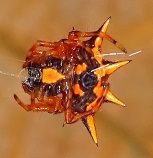 Along the way, I managed to take a reasonable good underside picture of a small orange spiny spider
(Gasteracantha species) on its thread. Top side picture was not possible due to the surrounding vegetation.
Along the way, I managed to take a reasonable good underside picture of a small orange spiny spider
(Gasteracantha species) on its thread. Top side picture was not possible due to the surrounding vegetation.
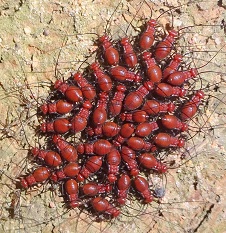
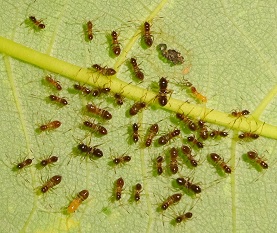 Finally, there were 2 gatherings of baby insects. One group was the reddish Tree Cattle or Barklice found on the trunk of
the Rubber Tree (Hevea brasiliensis). The other group consisted of
over 40 juvenile bugs found under the leaf of the
White-leafed Fig (Ficus grossularioides). As shared in
another note in January, Tree Cattle was relatively common in this Park. As
for the juvenile bugs, I had seen them a few times on this species of fig tree but had yet to identify their parents, though
I had suspected that it might be from the
superfamily Lygaeoidea (Seed bug).
Finally, there were 2 gatherings of baby insects. One group was the reddish Tree Cattle or Barklice found on the trunk of
the Rubber Tree (Hevea brasiliensis). The other group consisted of
over 40 juvenile bugs found under the leaf of the
White-leafed Fig (Ficus grossularioides). As shared in
another note in January, Tree Cattle was relatively common in this Park. As
for the juvenile bugs, I had seen them a few times on this species of fig tree but had yet to identify their parents, though
I had suspected that it might be from the
superfamily Lygaeoidea (Seed bug).